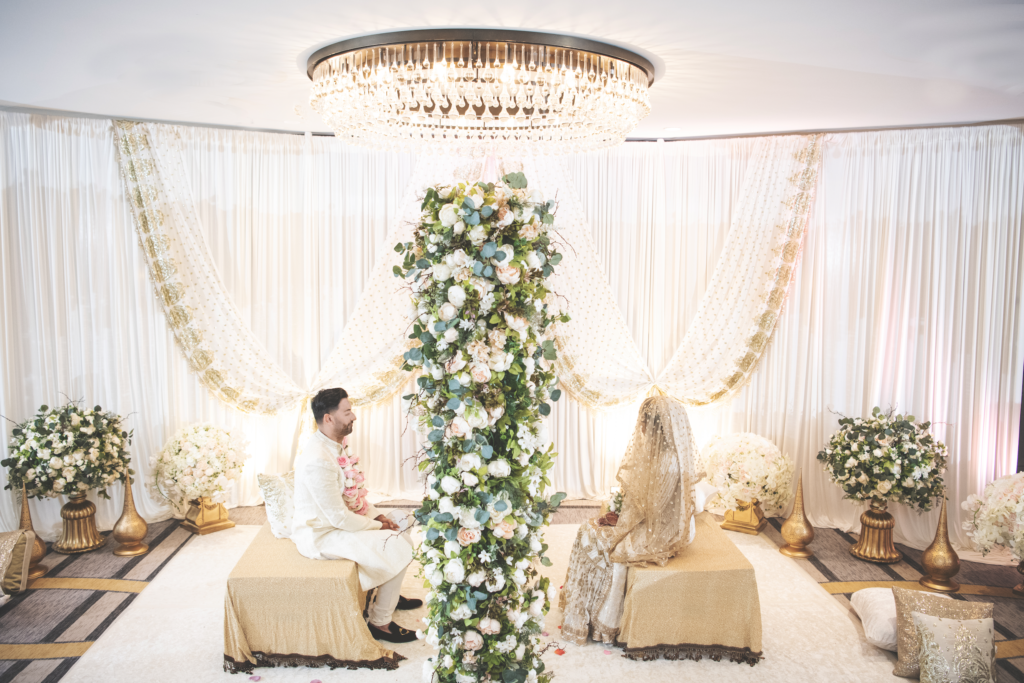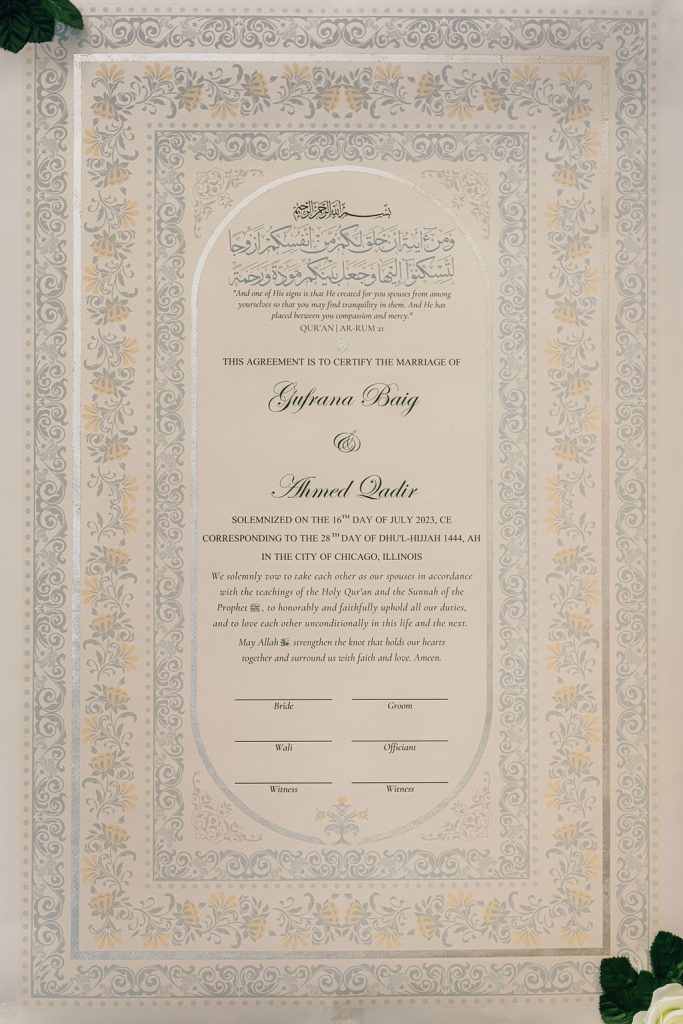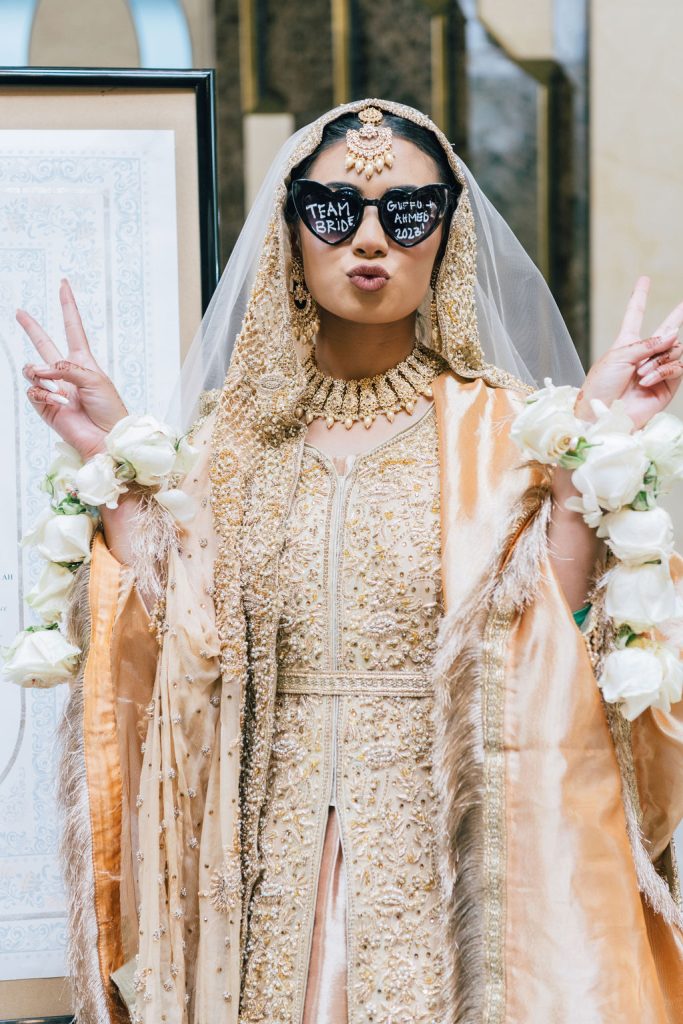You’re about to embark on a beautiful journey together, and your Nikkah ceremony is just around the corner.
As a seasoned wedding planner and photographer specializing in South Asian and multicultural weddings, I’ve witnessed countless couples tie the knot in stunning Islamic traditions.
Today, I’m here to guide you through the essentials of planning the perfect Nikkah ceremony and ensuring it’s a memorable, aesthetically pleasing affair.
Your Nikkah ceremony, a significant step in a Muslim marriage, deserves careful attention to detail. From legal documents to decor, we’ve got you covered. In this article, we first cover all the essential information you need to know about a nikkah ceremony. Later in the post, we dive into the must-have items for your Nikkah and invaluable planning advice to make your day seamless and picturesque.

What is a Nikkah Ceremony?
The nikkah ceremony is the religious muslim wedding ceremony. Muslims believe that marriage completes one half of a muslim’s religious obligations.
When does the Nikkah Ceremony take place?
Traditionally, the nikkah ceremony occurs soon after the couple and their families have agreed to proceed with the engagement. Most conservative families prefer that the couple have the nikkah performed so that they can spend time together in a halal (islamically approved) way.
Where does the Nikkah Ceremony take place?
Usually, a nikkah ceremony is planned in a mosque but it can take place anywhere. Most couples choose a Friday for their Islamic marriage either in the morning or in between prayer times.
How long is the Nikkah Ceremony?
A Nikkah ceremony is meant to be simple, quick and easy. The actual religious ceremony takes about 30 minutes or less.
What should be worn at a Nikkah Ceremony?
When attending a nikkah ceremony as a guest, wearing a modest outfit is key. It’s best to wear loose fitting festive clothes with full sleeves and a head covering like a scarf. Wearing revealing clothes is frowned upon and it’s best to be conservative.
What happens at the Nikkah Ceremony? Sample Timeline
Whether the nikkah ceremony is officiated at a mosque or different venue, this ceremony is designed to be short and simple. Here is a typical nikkah timeline:
Before the actual ceremony begins, the bride and groom might want to do solo portraits separately.
- Family and friends gather at the nikkah ceremony location. At a mosque, the women and bride are sitting separately from the men either on a different floor or on the opposite side of the men.
- Imam gets approval from bride that she wholeheartedly agrees to marriage without force and accepts Mahr.
- Groom enters and sits down next to imam, bride’s father/representative, and witnesses.
- Imam speaks about the nikkah ceremony and it’s importance in Islam.
- Imam asks both bride’s father and groom if they agree to marriage.
- Imam prays dua on behalf of the newlywed couple.
- After parents, family and loved ones congratulate the couple, groom meets his wife for the first time.
- At this time, there may be garland exchanges, signing of nikkah-nama, ring exchange, and family photos.
- Newlywed portraits
This entire timeline usually is 2-3 hours depending on if everyone is running on time and how long newlywed portraits last.
Don’t Forget These Essentials for Your Nikkah Ceremony
1. Nikkah Certificate and Marriage License Papers:
These documents are your golden tickets to legal wedded bliss. Keep them handy for the officiating Imam’s signature, and don’t forget to complete all the necessary paperwork before your big day.
2. Decorative Nikkah-Nama (Nikkah Contract) for Framing:
Having a nikkah-nama is a beautiful keepsake of your nikkah ceremony. This beautifully designed contract symbolizes your commitment and great for more unique photos. Frame it to commemorate your special day and cherish it forever on your wall.

3. Nikkah Pen:
A simple yet essential item for signing the contract. Choose one that aligns with your wedding’s aesthetic to add a personal touch.
4. Groom’s License/Passport/Official ID:
Ensure the groom has his identification documents to make the marriage legal and straightforward.
5. Bride’s Official ID:
The bride’s identification is equally crucial. Keep it within reach to avoid any last-minute hiccups.
6. Wedding Bands:
These precious rings are a tangible symbol of your love and commitment. Select ones that resonate with your style and preferences.
7. Aesthetic Ring Boxes:
Elevate the moment of exchanging rings with beautifully crafted ring boxes that match your wedding theme. We recommend a beautiful velvet ring box because of it’s timeless and romantic appeal.
8. Ring Tray:
Your photographer will thank you for this! A decorative tray for the rings not only looks great in photos but also keeps them safe and easily accessible.
9. Bride’s Veil (Ghoonghat):
This traditional veil adds a touch of mystique and elegance to the ceremony. Typically, a muslim south Asian bride will enter with a second veil (ghoonghat) over her face. The groom will lift the veil after the ceremony for the “first look”.
Choose one that complements your attire. The veil should be light weight and transparent so that the photographer can capture your reactions during the nikkah.
10. Favors:
Small tokens of appreciation for your guests, these add a delightful touch to your Nikkah.
11. Tray or Basket of Favors:
Keep these within reach for guests to pick up as they leave, ensuring a seamless distribution process.
12. Flower Garlands (Optional):
If you want to add a burst of color and fragrance to the ceremony, consider flower garlands for both bride and groom.
13. Gajras (Floral Bracelets – Optional):
An exquisite accessory for the bride’s wrists, these delicate floral bracelets are a lovely addition.
14. Gift/Donation to the Imam Officiating the Nikkah:
Show your gratitude by offering a gift or donation to the Imam conducting your Nikkah ceremony.
15. Nikkah Wedding Signage (Optional):
While not necessary, you can personalize your ceremony with signage that reflects your love story and theme.
16. Fresh Petals (Optional)
Shower these delicate petals for a romantic and visually appealing touch after the ceremony on the bride and groom. It’s best to do this outside to avoid a mess in the masjid. This is a great photo opportunity as well!
Planning Advice for a Perfect Nikkah:
Now that you’ve got your checklist sorted, here are some crucial planning considerations:
Photo/Video Permission:
Check if the masjid allows photography and videography during the Nikkah ceremony. Make necessary arrangements in advance.
Seating Arrangements:
Determine if men and women can sit on the same floor or if segregation is required. Plan for separate photographers/videographers if needed.
Imam’s Attire:
Ensure that the officiating Imam dresses appropriately for the occasion to maintain the aesthetic and significance of your photos and videos.
Mixed Family Photos:
Find out where co-ed family photos can be taken after the Nikkah in the masjid. Look for a designated room or space for mixed gatherings.
Nikkah Schedule:
Verify if there are any Nikkah ceremonies before or after yours, as this may impact your timeline. If there are other weddings happening at the mosque, you and your families may have a limited window after the nikkah to mingle and take photos in the masjid.
Family Photo List:
Prepare a list of family group photos to streamline the photography process and capture all essential moments.
Signing the Decorative Nikkah-Nama:
Don’t forget to sign the decorative Nikkah-Nama after the marriage ceremony; it’s a cherished keepsake.
Flat-Lay Photography:
Coordinate with your photographer to create an exquisite flat-lay of your Nikkah-Nama, pen, flower petals, rings, ring boxes, and veil for stunning visuals.
Solo Bridal and Groom Shots: Capturing the Essence Before the Ceremony
Before the hustle and bustle of your Nikkah ceremony begins, take a moment to capture the solo beauty of both the bride and groom. These individual shots are a fantastic way to document your unique style and personality before becoming partners for life.
Bridal Portraits:
Brides, this is your time to shine!
Schedule a quiet moment before the ceremony when you’re fully dressed in your bridal attire, including your stunning gown, makeup, and jewelry. These solo shots can showcase the intricate details of your outfit and the radiance of your smile. Here are some tips for your bridal portraits:
- Timing: Plan to have your bridal portraits taken well before the ceremony starts. This allows you to remain stress-free and fully present during the Nikkah.
- Location: Coordinate with your photographer to choose a suitable location. Some brides prefer the serene ambiance of the masjid or venue, while others opt for a separate outdoor spot with natural light.
- Posing: Work with your photographer to create poses that highlight your gown, veil, and accessories. Don’t forget to capture close-up shots of your henna-adorned hands and any other meaningful details.
- Emotion: Let your emotions shine through in these pictures. Express joy, excitement, and anticipation, as these moments are a celebration of your journey.
Groom Portraits:
Grooms, it’s your turn to step into the spotlight!
Much like the bride, you can have solo shots taken to capture your dapper attire and confident demeanor. Here’s how to make the most of your groom portraits:
- Preparation: Ensure you’re fully dressed in your wedding attire, complete with any accessories or cultural elements that hold significance.
- Timing: Like the bride, schedule your portraits well before the ceremony begins. This allows you to enjoy the process and stay relaxed.
- Location: Whether you prefer the elegance of the masjid or an outdoor setting, discuss the location with your photographer to ensure it complements your style.
- Posing: Work with your photographer to create poses that showcase your attire, such as your sherwani, suit and shawl. Don’t be afraid to showcase your personality and emotions.
- Confidence: Remember, these portraits are a testament to your journey into marriage. Exude confidence and excitement, and let your eyes reflect the love you have for your future spouse.
Post-Ceremony Location for Couple Shots:
After the Nikkah ceremony, it’s the perfect time to capture romantic couple shots. You have a couple of options for locations:
- Onsite at the Masjid/Venue: If the masjid or venue offers a picturesque backdrop, take advantage of it for your couple shots. You can use the beautiful architecture, garden, or any other scenic spot available.
- Offsite at a Quiet Outdoor Location: Alternatively, if you prefer a more natural and serene setting, consider an offsite location for your couple shots. Nearby parks, gardens, or any other picturesque spots can provide a beautiful backdrop for your photos.
Whichever location you choose, ensure it aligns with your overall wedding theme and vision. Work closely with your photographer to plan the timing and details for these shots. Capturing these moments will add a touch of romance and beauty to your wedding album.
Incorporating solo bridal and groom shots and post-ceremony couple shots into your Nikkah photography plan ensures that every aspect of your special day is documented with care and creativity. These photos will serve as timeless mementos of your love story and the beginning of your journey as a married couple.

Conclusion
Your Nikkah ceremony is a momentous occasion, and meticulous planning is the key to making it truly unforgettable.
By following this comprehensive checklist and considering the essential planning advice, you’ll ensure that your Nikkah is not only legally binding but also a beautifully captured and cherished memory.
To learn more about more South Asian wedding traditions, read more here.
May your journey together be filled with love, happiness, and endless blessings!




